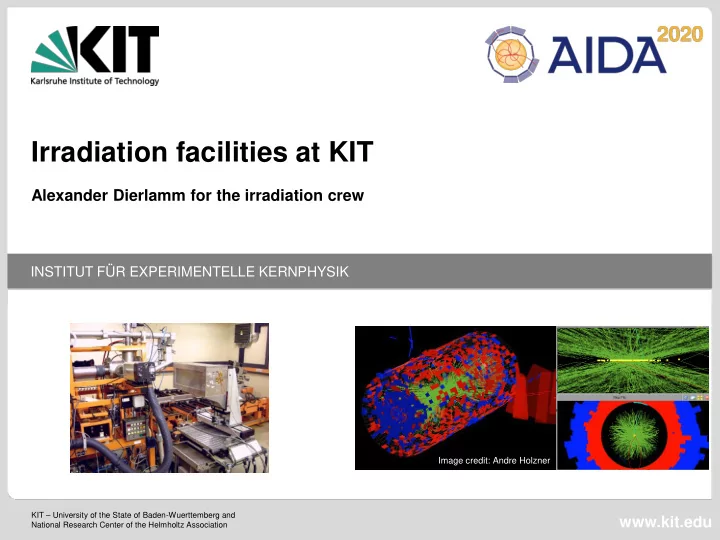

Irradiation facilities at KIT Alexander Dierlamm for the irradiation crew INSTITUT FÜR EXPERIMENTELLE KERNPHYSIK Image credit: Andre Holzner KIT – University of the State of Baden-Wuerttemberg and www.kit.edu National Research Center of the Helmholtz Association
The infrastructures Available facilities: 23MeV proton cyclotron On average 4-5h slot every second week up to 6 weeks turn-around time 60kV X-ray tube currently heavily used, but still we can try to arrange for irrad. time Initial contact and infos: irradiations@lists.kit.edu Description on http://www.ekp.kit.edu/english/irradiation_center.php A. Dierlamm 2 4.6.2015 Irradiation facilities at KIT Institut für Experimentelle Kernphysik
The Karlsruhe Proton Cyclotron KAZ Run by private company ZAG Proton energy at extraction: 25.3MeV Typical proton current: 2.0µA Temperature in box: ~ -30°C FWHM~7mm Beam spot ~ 7mm (varying) Flux ~ 3x10 13 p/(s·cm²) Sample box on XY-stage with beam line Man placing LN 2 box Control room A. Dierlamm 3 4.6.2015 Irradiation facilities at KIT Institut für Experimentelle Kernphysik
Irradiation Box Insulated box, cooled by cold nitrogen gas Goose-necks lead gas to individual samples Graphite plate to stop protons at the back Window with two Kapton foils for insulation Samples glued on Kapton tape fixed to Al-frames, which can be fixed in the box Mounted on movable XY-stage since beam spot does not cover samples size; max. accessible area: ~ 40cm x 15cm Box positions and temperatures are logged A. Dierlamm 4 4.6.2015 Irradiation facilities at KIT Institut für Experimentelle Kernphysik
Scanning Procedure Samples are scanned in 1mm spaced rows Edge regions are inhomogeneous and a margin of ~1cm is used Proton fluence is calculated by: The proton current I P is always measured at the last beam stop At the nominal values of I P =2.0µA and v x =115mm/s we generate 4.3x10 13 n eq /cm² per scan Fluence can be predicted to ~20% Autoradiographic image of a large Ni-foil scanned in the described Dosimetry of Ni foil will yield a procedure. The white area is a cut fluence measurement within ~15% out for further dosimetry. A. Dierlamm 5 4.6.2015 Irradiation facilities at KIT Institut für Experimentelle Kernphysik
Energy at Target 25.3MeV is the proton energy at extraction Protons have to pass several materials until they hit the samples SRIM calculations for the proton energy: entering the samples: 23.8MeV on average in the sample: 22.9MeV ( 23MeV protons quoted) Hardness factor for p 23MeV on Si: 2.0 i.e. 1x10 14 p/cm² 2x10 14 n eq /cm² SRIM 2008.04 A. Dierlamm 6 4.6.2015 Irradiation facilities at KIT Institut für Experimentelle Kernphysik
Restrictions Gluing of samples with Kapton tape max. fluence: 5x10 15 n eq /cm² (silicone glue gets brittle) Possibly remnants on the samples, which should be removable with acetone, isopropanol or a sticky tape We cannot book irradiation time weeks before. On Mondays the plan of the week is made and if there is a free slot we can get it Usually, we can get one session (~5h) per week We handle the projects in FIFO mode; so send samples asap Materials possibly only silicon with aluminum auxiliary electronics/components/metal traces should be covered by an Al99.5 mask A. Dierlamm 7 4.6.2015 Irradiation facilities at KIT Institut für Experimentelle Kernphysik
Shipment Samples can be shipped to us and we do the rest Most of the samples need to be kept cold after irradiation they are immediately stored in a freezer after irradiation you need to supply an insulating box with ice packs / dry ice Shipment is done after a deactivation time of ~ 1 week and consecutive dosimetry A. Dierlamm 8 4.6.2015 Irradiation facilities at KIT Institut für Experimentelle Kernphysik
Scientific outcome Could count 61 user publications since 2008 of which 27 since 2013 Please, let us know when you submit a publication! … A. Dierlamm 9 4.6.2015 Irradiation facilities at KIT Institut für Experimentelle Kernphysik
Examples: planar strip sensors 2013 JINST 8 C01001 NIM A612(2010)470 – 473 A. Dierlamm 10 4.6.2015 Irradiation facilities at KIT Institut für Experimentelle Kernphysik
Examples: 3D sensors NIM A659(2011)272 – 281 A. Dierlamm 11 4.6.2015 Irradiation facilities at KIT Institut für Experimentelle Kernphysik
Examples: electronics Transistors indico.cern.ch/event/ Read-out ASICs 357738/session/5/ contribution/74 HV-CMOS … Pixel ROC HV Transistors HV-CMOS http://dx.doi.org/10.1016/j.nima.2015.09.004 http://smwang.web.cern.ch/smwang/ ITK_sep14_web/HV_update.pdf A. Dierlamm 12 4.6.2015 Irradiation facilities at KIT Institut für Experimentelle Kernphysik
Application First contact us and discuss your project: irradiations@lists.kit.edu If you are eligible to apply for AIDA-2020 funds you should fill out an application form and follow these instructions: http://aida2020.web.cern.ch/content/how-apply-transnational-access You can also directly pay us for an irradiation project… For AIDA funded projects please do not forget to add an AIDA-2020 acknowledgement to you publication: Pub. long: Pub. short: Presentation: A. Dierlamm 13 4.6.2015 Irradiation facilities at KIT Institut für Experimentelle Kernphysik
X-Ray setup max. voltage: 60kV max. current: 30mA beam spot diameter ~ 2cm dose rate (SiO 2 ): <2Gy/s feed-through for test equipment X-ray setup with laser alignment and camera NIM A675(2012)118 – 122 A. Dierlamm 14 4.6.2015 Irradiation facilities at KIT Institut für Experimentelle Kernphysik
Examples: Pixel calibration Fluorescence targets for energy calib. Intensity scan for rate dependence IEKP-KA/2013-21 A. Dierlamm 15 4.6.2015 Irradiation facilities at KIT Institut für Experimentelle Kernphysik
Conclusion If you are planning an irradiation please talk to us: irradiations@lists.kit.edu We are ready… Cyclotron X-rays M. Stanley Livingston and Ernest O. Lawrence (right) in front of Lawrence's Taking an X-ray image with early Crookes tube apparatus, late 1800s. 69 cm (27 in) cyclotron at the Lawrence Radiation Laboratory. The curving The Crookes tube is visible in center. The standing man is viewing his metal frame is the magnet's core, the large cylindrical boxes contain the coils hand with a fluoroscope screen. No precautions against radiation of wire that generate the magnetic field. The vacuum chamber containing the exposure are taken; its hazards were not known at the time. "dee" electrodes is in the center between the magnet's poles. https://en.wikipedia.org/wiki A. Dierlamm 16 4.6.2015 Irradiation facilities at KIT Institut für Experimentelle Kernphysik
Recommend
More recommend